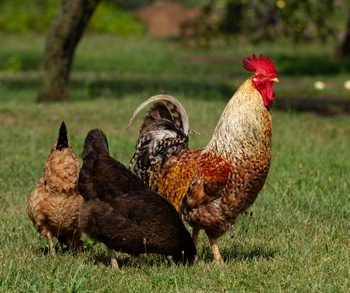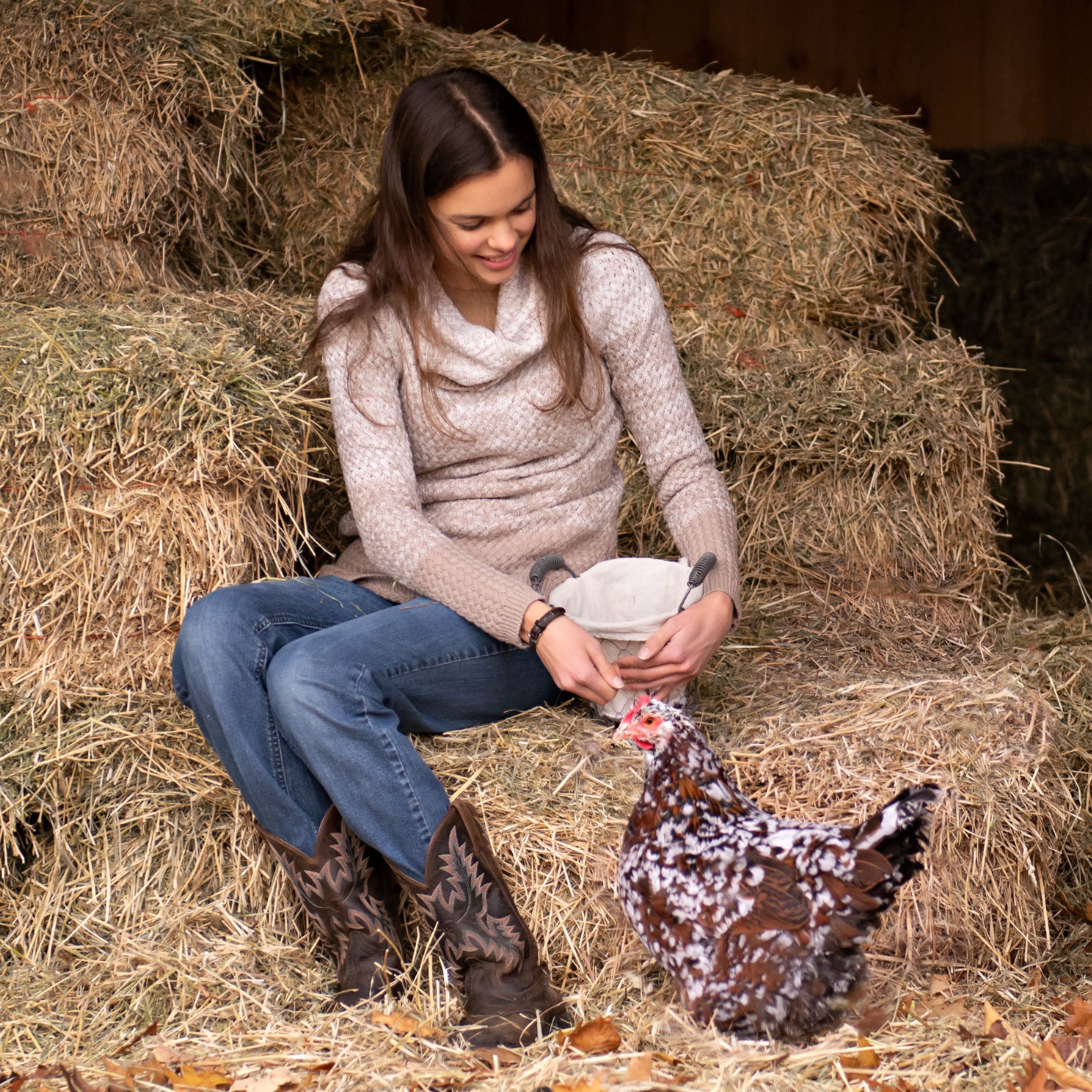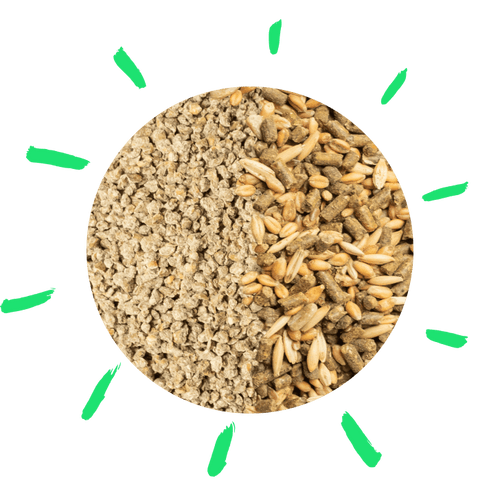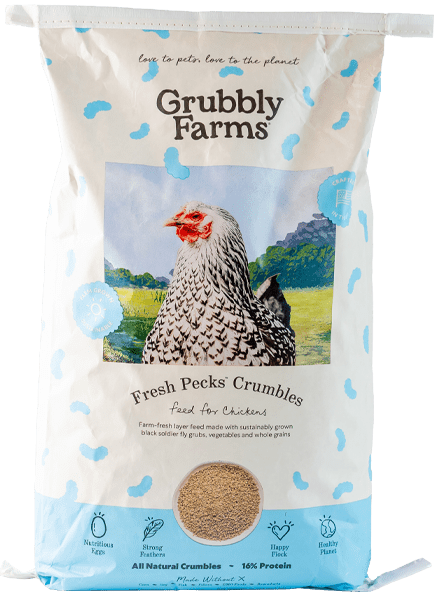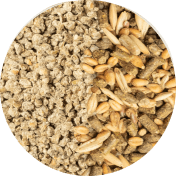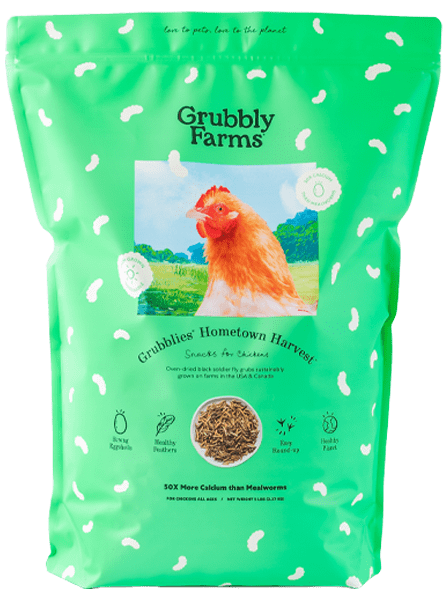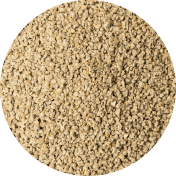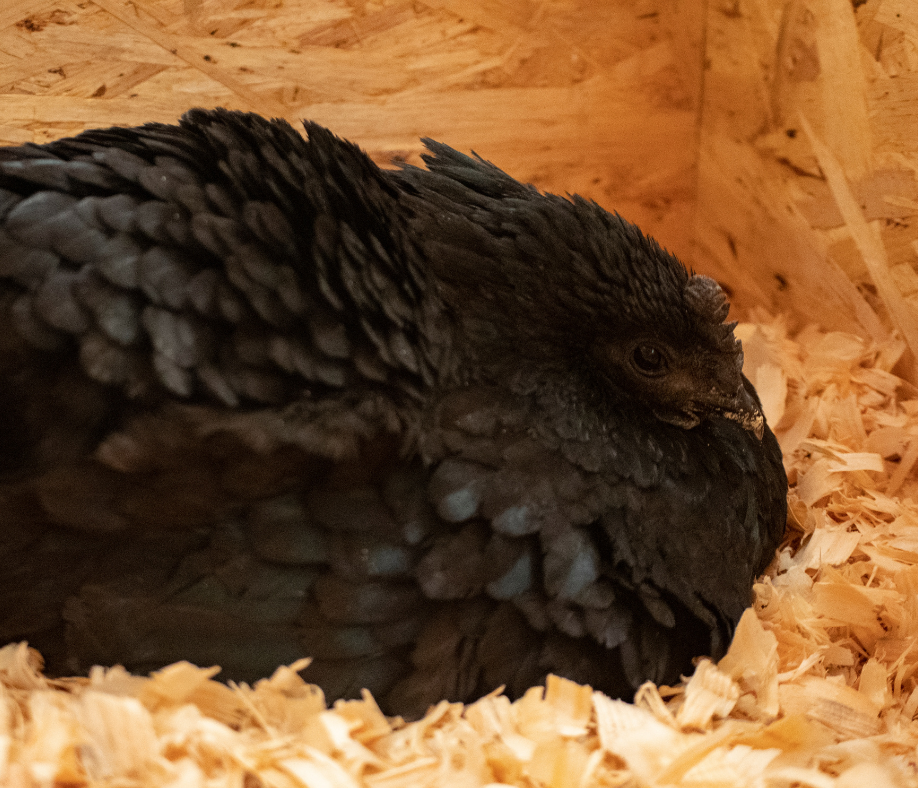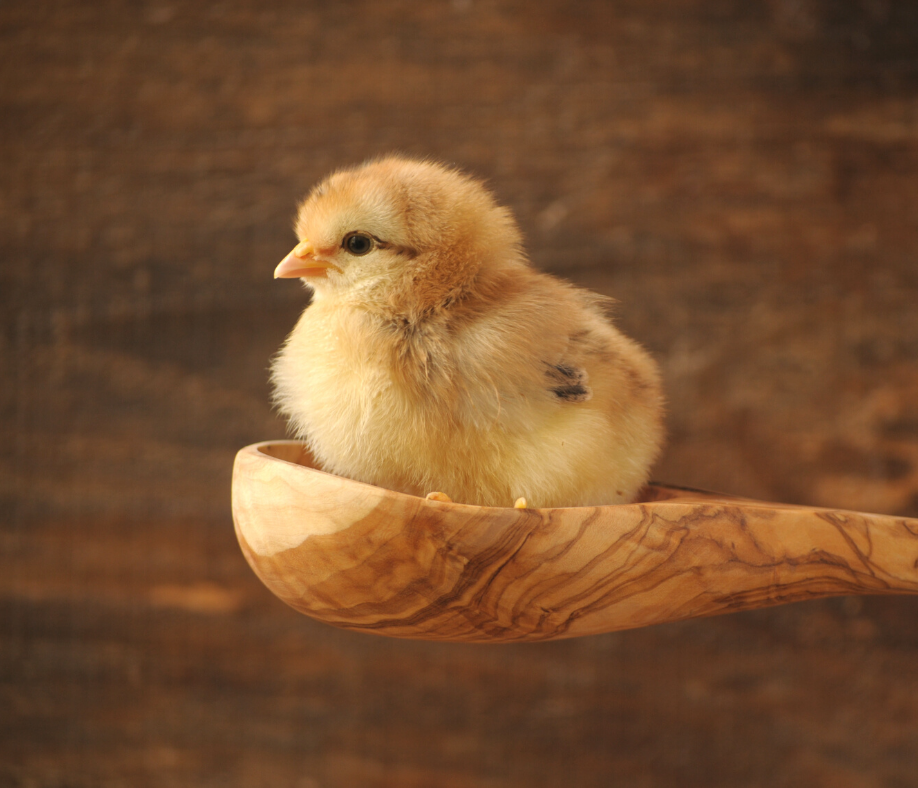Whether you’ve hatched out a brood of chicks, bought straight-run chicks, or even bought sexed chicks, knowing which birds are hens and which ones are roosters can be tricky! Chickens have about a 50/50 gender ratio, meaning about 50% of fertile eggs will hatch as roosters and 50% will be hens.
In general, when baby chicks first hatch, there are few ways to accurately identify their sex–and no 100%, fail-proof accurate assessment method. However, as they mature, there are some tell-tale characteristics to be on the lookout for when identifying if you have roosters, hens, or a mixture of both in your flock! We will cover how to spot the signs of a rooster or a hen as your chickens grow and mature.
Roosters vs. Hens: Behavior & Physical Differences

Distinguishing between an adult rooster and an adult hen is pretty straightforward in most chicken breeds. You can tell a rooster apart from a hen based on the observable differences in external appearance as well as based on certain behaviors.
Physical Characteristics of a Rooster

- Saddle Feathers
- Long Tail Feathers & Main Sickle Feather
- Pointy-shaped Saddle & Hackle Feathers
- Spurs
- Large Comb & Wattles
- Bright Facial Color
- Plumage Color (in some chicken breeds)
Rooster Feathers
When it comes to feathering, roosters will have saddle feathers and a main sickle that hens do not have. The saddle feathers are long feathers that cover the rump and base of the rooster's tail. Hens have feathers there as well, but they are not often referred to as saddle feathers.
The sickle feather is located in a rooster’s tail and is the main long feather in the tail. Roosters characteristically have pointy-shaped hackle feathers (neck feathers) and saddle feathers.
Other External Physical Features of Roosters
As far as external features go, roosters will often have larger combs and wattles than hens. The coloring of their combs, wattles, earlobes, and faces will also be more vibrant than a hen’s facial features. However, when a hen is in peak production, her facial features can also appear quite vibrant.
Most mature roosters will also have spurs on their shanks which will continue to grow and get longer as the rooster ages. Roosters of certain chicken breeds or varieties may also have different plumage colors than hens of the same breed or variety.
Behavioral Characteristics of a Rooster
You can also identify a rooster based on characteristic behaviors. These behaviors that will indicate your chicken is a rooster, include:
- Tidbitting: A type of ground pecks
- Courting: Waltzing, wing batting, and strutting
- Crowing
- Guard Behavior
- Mounting Hens
- Sparring and other aggressive behaviors
Roosters can start to perform these behaviors (or at least try) starting at a very young age (often around 4 months or earlier). So, these characteristics can also be helpful when trying to sex young chickens.
Physical Characteristics of a Hen

- Short, Rounded Hackle Feathers
- No Main Sickle
- No Long Saddle Feathers
- No Spurs (in most breeds)
- Smaller Comb & Wattles
- Plumage Color (in some chicken breeds & varieties)
Hen Feathers
Hens will have shorter, more rounded feathers than roosters. Their hackle feathers won’t be pointed, and they will lack the long saddle feathers and tail feathers that are characteristic of roosters.
Other External Physical Features of Hens
Hens will also have smaller facial features, such as a smaller comb and wattles compared to a rooster. This holds true for most breeds no matter what comb type they have.
Behavioral Characteristics of a Hen
Hens also exhibit behaviors that differ from roosters. Most hens will not court, crow, mount, or spar. Broody hens will often exhibit the behavior of tidbitting when they are raising a brood of chicks and some hens will take on guard behaviors if a rooster is not present in the flock.
However, there are also some behaviors that are unique just to hens:
- Egg Laying
- Egg Song
- Broodiness
- Squatting for Mating
Keep in mind that in rare cases, a hen may start exhibiting rooster-like behaviors. This most often happens with rooster-less flocks or if the hen has been raised with mostly roosters.
Sexing Confusion Among Some Chicken Breeds

Things can get a little confusing with some chicken breeds. There are some types of chickens in which both sexes have spurs or in which the roosters are hen-feathered. For example, in Silver Leghorns, the roosters and the hens develop spurs on their shanks.
In other breeds, like the Silkie or Golden Campine, roosters are considered ‘hen feathered.’ This means they lack the distinctive saddle and sickle feathers characteristic of roosters.
How to Determine If Chicks are Male or Female

Identifying the sex of adult chickens can be fairly easy. However, flock owners don’t always want to wait until a chicken is full-grown to discover whether it is a rooster or a hen. This requires sexing chicks. Determining if a chick is a future hen or rooster is a little trickier, though. Luckily, there are four main methods that you can use to sex your baby chicks. Just keep in mind that even experts are only 90% accurate.
#1. Auto-Sexing Through Coloration

Auto-sexing is a method of sexing chicks based on the color, pattern, or distinguishing characteristic of the chick’s down feathers as soon as it hatches. This method only works on breeds that present different colorations for males and females as chicks. Auto-sexing breeds are always purebreds and never crosses or hybrids.
Sometimes the sex indicator can be as simple as the male chicks having a light-colored dot on their head or the females having a different dorsal stripe pattern.
Some chicken breeds that can be auto-sexed include:
- Barred Plymouth Rock: Males have irregular or elongated spots on their heads, and females have defined head spots and yellow toes.
- Silver Duckwing varieties: Males have a light dorsal stripe that ends with a dot on the head, and females simply have a dark dorsal stripe
- Buckeye: Males have a white/cream color spot on their upper wings, and females have a dark spot on their heads.
- Silver Leghorn: Males have lighter dorsal stripes and females have darker dorsal stripes.
#2. Sex-Linked Coloration & Feather Growth
Sex-linking is another method many people use to distinguish a pullet from a cockerel. This method is based on the color of a chicken’s feathers and/or the growth rate of feathers.
Color-linked sexing is based on the color of the down feathers and adult plumage. Roosters will be one color and hens will be a different color.
Feather-linked sexing is based on how fast the wing and tail feathers mature in 1- to 2-day-old chicks. By the time the chicks are 3+ days old, the rate at which the roosters and hens mature become too similar and feather sexing will not be as accurate.
What Chickens Can Be Sex-Linked?
Most sex-linked chicken breeds are hybrids. The sex-linking genes are achieved by crossing a male and female chicken of two different breeds to achieve sex-linked offspring. The offspring cannot be bred to create more sex-linked offspring. However, some purebred chicken breeds can be feather-linked sexed based on their feather maturity rate.
Some chicken breeds that are sex-linked include:
- California White
- Black Star (also called Black Sex-Links or Black Rocks)
- Red Sex-Links or Red Stars
- Golden Comet
- Cinnamon Queen
#3. Vent Sexing
Vent sexing is a method that can be used on any breed of chick by examining just inside of a chick’s vent (where feces and eggs exit the body). The presence or lack of female reproduction parts indicates if the chicken is a future rooster or hen.
Unfortunately, this isn’t a method most backyard flock keepers can use. Given the nature of vent sexing, it is best done by professionals who have been trained to safely perform vent sexing. Since chicks are so small and fragile, vent sexing can result in injury if it is done incorrectly.
Most hatcheries who sell chicks pre-sexed use vent sexing as the method of sexing the chicks. However, vent sexing is not always accurate. This is why you might end up with a rooster even though you bought chicks who were being sold as hens.
#4. Sexual Dimorphism
If you aren’t raising an auto-sexing breed or a sex-linked breed, and since vent sexing isn’t an option for most backyard chicken keepers, your last option for sexing chicks is sexual dimorphism. As technical as it sounds, sexual dimorphism is simply the method of identifying a chick’s sex as it matures and starts to exhibit physical and behavioral characteristics indicative of hens and roosters.
Even though sexual dimorphism may not be able to be used as soon as chicks hatch, it can be useful as the chicks mature. In some breeds, you may be able to use this method to tell the male and female chicks apart as soon as 2 to 3 weeks.
When using sexual dimorphism, you are looking for observable changes in behavior or appearance. It is most helpful when you are raising straight-run chicks since you will more than likely have both male and female chicks to compare to each other as they mature.
How to Identify a Pullet vs a Cockerel Using Sexual Dimorphism

Using sexual dimorphism to sex your chicks allows you to distinguish between a cockerel (a male chicken under 1 year of age) and a pullet (a female chicken under 1 year of age). Cockerels and pullets are basically miniature versions of adult roosters and hens, hence their behaviors and appearance will mimic an adult rooster’s or hen’s behaviors and appearance.
Here are some characteristics to keep an eye out for as your chicks grow and mature:
Cockerels:
- Larger comb & wattles
- Longer tail
- Pointier-shaped feathers (look at the neck and saddle feathers)
- Stockier legs & stockier body
- Sparring
- Attempting to crow
- Tibitting
- Trying to court & mount pullets
- More alert and aware of their surroundings
- Bolder and more adventurous
In some breeds, these characteristics will become obvious more quickly. Chicken breeds that are fast maturing or whose roosters mature quickly are easier to sex at a young age.
Pullets
- Smaller comb & wattles
- Shorter tail
- Rounded feathers
- Thinner, more petite build
- Squat at perceived danger, including when a cockerel approaches, or when you go to pick her up
- Hang out with other pullets and take on more of a flock mentality
- Responds to cockerel’s tidbitting or courting
Pullets will be easier to identify if you have at least one cockerel in your brood, that way you can compare the pullets’ maturity to the cockerel’s behaviors and appearance.
How to Tell Hens from Rooster in 8 Popular Chicken Breeds
While the tips above for sexing both adult chickens and young chickens work for any chicken breed. However, some chicken breeds have some unique features that can more easily help you determine a rooster from a hen.
Here are 8 common chicken breeds and some tips for telling roosters apart from hens at a young age:
#1. Silkie Hen vs Rooster

Silkies are probably one of the hardest breeds to sex at a young age. The easiest way to tell roosters apart from hens is by knowing what characteristics are unique to young male Silkies.
Here are some things to look for in young Silkie roosters:
- Development of streamer feathers (long feathers that stick out from crest) around 7 weeks of age versus hens who have more rounded, even crests.
- An erect posture with their chest more forward and tail more upright.
- A stockier body and thicker legs.
- A large U-shaped comb versus hens who have a more V-shaped comb.
- Early developing wattles (often much sooner than hens).
#2. Barred Rock Rooster vs Hen

Barred Plymouth Rocks are actually an auto-sexing breed. The auto-sexing characteristics are not 100% accurate in the barred variety, but if you get birds with good genetics the following auto-sexing traits should hold true for sexing the chicks:
- Roosters: Larger & splotchy head spot and lighter silvery down color.
- Hens: More defined head spot and down is very black in color
You may hear that some people say male Barred Rocks are white with black stripes while female Barred Rocks are black with white stripes. This is accurate in that the roosters have a lighter coloration overall.
#3. Rhode Island Red Rooster vs Hen

To sex Rhode Island Red chicks, you will have to use sexual dimorphism as the chicks mature and grow. If you bought straight-run Rhode Island Red chicks, you will probably have a mixture of both males and females which can make comparing the two easier as they mature.
Here are some traits to look for in Rhode Island Red pullets and cockerels:
- Roosters: A stocky & block-shaped body, thicker & longer legs, large feet, taller comb, and bigger wattles that are bright red.
- Hens: short and rounded feathers, more pink-colored comb and wattles, smaller frame.
#4. Ameraucana Rooster vs Hen

Along with the Silkie, Ameraucana and Easter egger chickens are also very hard to sex at a young age. Like the Silkie, the easiest way to sex Ameraucana chicks as they mature is to identify the male chicks. If a chick is starting to show the following traits, then it is more than likely a rooster:
- Comb and wattles grow faster and are larger & redder (noticeable around 6-8 weeks of age).
- Pointed hackle and saddle feathers (noticeable around 10-12 weeks of age).
- Thicker legs & bigger feet.
- Bolder personality.
#5. Easter Egger Rooster vs Hen

Easter Egger chickens are not a purebred chicken breed. They are a mixed breed that can come in a variety of colors, which makes sexing them at a young age very difficult. Using the sexual dimorphism tips, you should be able to start distinguishing male and female traits in your chicks as they grow.
However, here are some additional tips that can be helpful for sexing young Easter Egger chickens:
- Roosters: Tend to have separate colors for their head and neck plumage, often more splotchy coloring, pointy and longer feathers, and a redder comb.
- Hens: More even color pattern, rounded feathers, small comb & wattles.
#6. Buff Orpington Hen vs Rooster

Buff Orpington chickens can sometimes be feather-sexed at a young age. However, feather-sexing is not always 100% accurate with Buff Orpingtons. Luckily, Buff Orpingtons are also a fast-maturing breed, which means the traits that distinguish roosters from hens will become apparent more quickly than in other breeds that mature slowly.
Chicks that are larger, stockier, have thicker legs, and start to develop a larger comb and wattles will more than likely be roosters. Chicks that are smaller and who have shorter, more petite legs will more than likely be hens. Roosters will also carry themselves more upright than hens.
Additionally, here is how Buff Orpington chicks can be feather sexed:
- Roosters: Feather slower and have shorter primary and secondary wing feathers as chicks.
- Hens: Develop wing and tail feathers sooner, round and neat feathers, longer wing feathers as pullets, and will develop lighter plumage.
#7. Polish Rooster vs Hen

Polish chickens are another breed of chicken that can be tricky to sex at a young age. Noticing differences between the roosters and hens as they mature is harder and the chicks may need to grow for longer before you can see any noticeably different traits.
Polish roosters will develop larger, more red combs and wattles versus the hens who will have smaller, more pale combs and wattles. Polish roosters will also grow longer tail feathers and be overall bigger and heavier than a Polish hen.
You can also observe how the crest on a young Polish chicken grows to determine the bird’s sex:
- Roosters: More rectangular & loose crest with streamer crest feathers (long feathers that stick out from the crest).
- Hens: A rounded & tight crest
#8. Silver-laced Wyandotte Rooster vs Hen

Silver-laced Wyandotte chickens are a heavy breed of chicken in which both the roosters and the hens have the same silver-laced coloring. Sexing the chicks at a young age can be done through sexual dimorphism.
Here are some tips for sexing young Wyandottes as they grow:
- Roosters: Larger & redder combs and wattles (noticeable around 8 weeks of age), thicker legs, and a stockier build.
- Hens: Shorter & thinner legs and rounded feathers (look at the hackle and rump feathers).
Hen or Roo? Now You Know!

While you may not be 100% positive about the sex of a chicken until he crows or she lays an egg, you can still develop a good idea of their sex based on distinguishing features. Whether it’s your first time hatching chicks or whether you buy chicks from a hatchery or breeder, knowing these tips for sexing chickens can be helpful for determining how many hens and how many roosters you might have in your backyard flock! Over time, you will become more and more familiar with the subtle differences between young roosters and hens.
Keep in mind, some breeds are more difficult than others to sex, but the longer you raise one breed the better you will get at sexing the chicks at a young age. If you want to skip the stress, opt for auto-sexing breeds or sex-linked breeds. They make the process easy right from the get-go! Whether it’s your first time hatching chicks or purchasing from a hatchery or breeder, determining how many hens and how many roosters you might have in your backyard flock is extremely useful.
